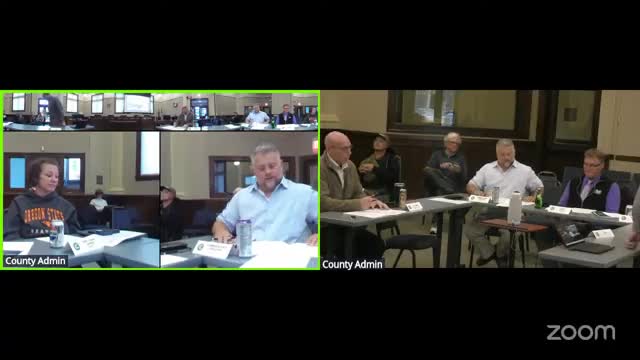Clatsop County staff recommend opting into state tobacco retail licensing, keep 1,000-foot school buffer
October 23, 2025 | Clatsop County, Oregon
This article was created by AI summarizing key points discussed. AI makes mistakes, so for full details and context, please refer to the video of the full meeting. Please report any errors so we can fix them. Report an error »

Clatsop County public-health staff told the Board of Commissioners that the county intends to opt into Oregon’s state tobacco retail licensing program and amend the county ordinance to remove duplicate county provisions while keeping one local restriction: a 1,000-foot buffer prohibiting tobacco sales around schools.
A staff presenter explained that Clatsop County adopted a local tobacco retail license ordinance in 2020 and the state enacted a retail license program in 2022. The county asked the Oregon Health Authority about opting in to the state program last spring; under state opt-in the county could perform inspections while the state would handle violations and appeals.
Staff said county invoices for current local licenses will be prorated for the remainder of the fiscal year because the county’s ordinance will remain in effect until the county officially opts into the state program, which staff said is planned to be effective July 1, 2026. Under the state program, inspections would still be performed locally and the state would reimburse the county for inspection work. The staff presenter said the county currently charges $350 for a retail license and that the state’s current rate is $953; the state reimbursement for inspections would be $380 in the staff example.
Retailers told staff they generally prefer a single state license when they operate in multiple counties, staff said, because county rules differ across jurisdictions. Staff estimated there are about 60 retailers in Clatsop County subject to the license and described the county’s current enforcement as a progressive structure that can lead to loss of license for repeat violations; appeals in the current county system go through county counsel and the county manager.
The presenter described inspection practice: regular yearly inspections plus compliance checks that use an underage buyer to test for illegal sales. Complaints sometimes come from other retailers who observe couponing or sales prohibited under county rules.
Commissioners asked whether the state reimbursement covers county costs for inspections and enforcement. Staff said the state’s inspection payment does not fully cover the county’s total program costs, especially when appeals or multiple inspections are needed, and acknowledged the county may need to revisit fees or cost allocations if enforcement work continues to exceed the direct inspection reimbursement.
Staff said they will return to the board with a draft ordinance that removes redundant county provisions, retains the 1,000-foot school-sales prohibition and explains the transition for retailers and their prorated invoices.
A staff presenter explained that Clatsop County adopted a local tobacco retail license ordinance in 2020 and the state enacted a retail license program in 2022. The county asked the Oregon Health Authority about opting in to the state program last spring; under state opt-in the county could perform inspections while the state would handle violations and appeals.
Staff said county invoices for current local licenses will be prorated for the remainder of the fiscal year because the county’s ordinance will remain in effect until the county officially opts into the state program, which staff said is planned to be effective July 1, 2026. Under the state program, inspections would still be performed locally and the state would reimburse the county for inspection work. The staff presenter said the county currently charges $350 for a retail license and that the state’s current rate is $953; the state reimbursement for inspections would be $380 in the staff example.
Retailers told staff they generally prefer a single state license when they operate in multiple counties, staff said, because county rules differ across jurisdictions. Staff estimated there are about 60 retailers in Clatsop County subject to the license and described the county’s current enforcement as a progressive structure that can lead to loss of license for repeat violations; appeals in the current county system go through county counsel and the county manager.
The presenter described inspection practice: regular yearly inspections plus compliance checks that use an underage buyer to test for illegal sales. Complaints sometimes come from other retailers who observe couponing or sales prohibited under county rules.
Commissioners asked whether the state reimbursement covers county costs for inspections and enforcement. Staff said the state’s inspection payment does not fully cover the county’s total program costs, especially when appeals or multiple inspections are needed, and acknowledged the county may need to revisit fees or cost allocations if enforcement work continues to exceed the direct inspection reimbursement.
Staff said they will return to the board with a draft ordinance that removes redundant county provisions, retains the 1,000-foot school-sales prohibition and explains the transition for retailers and their prorated invoices.
View the Full Meeting & All Its Details
This article offers just a summary. Unlock complete video, transcripts, and insights as a Founder Member.
✓
Watch full, unedited meeting videos
✓
Search every word spoken in unlimited transcripts
✓
AI summaries & real-time alerts (all government levels)
✓
Permanent access to expanding government content
30-day money-back guarantee

